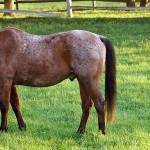Vitamin E, Oxidative Stress, and PPID in Horses: Is There a Link?

Like humans, horses age slowly compared to other species. One theory suggests that excessive oxidation occurs as antioxidant function wanes with age. With this in mind, providing horses with antioxidants such as vitamin E could help to protect horses from age-related conditions.
Free radicals are produced during oxidation, a normal body process that occurs in all horses. Innate antioxidant systems within cells squelch free radicals before they become harmful. As horses age, however, experts suggest that antioxidant systems lose efficiency, and all cells become overwhelmed by damaging free radicals.
Pituitary pars intermedia dysfunction (PPID, Cushing’s disease) is considered by many to be an age-related disease. This condition occurs primarily in older horses and is caused by nerve degeneration in the region of the brain called the hypothalamus. That degeneration causes hormone-producing cells in the brain to grow abnormally, forming microadenomas. Those growths produce high levels of various hormones such as adrenocorticotropin hormone (ACTH) that negatively affect various body systems.
Clinical signs of PPID that develop secondary to high ACTH levels include hair coat abnormalities, behavioral disorders, lethargy, chronic laminitis, excessive drinking and urination, and neurological signs such as incoordination.
Several research groups hypothesize that advanced age and the presence of age-related disorders such as PPID could be associated with impaired antioxidant pathways and oxidative stress (excess free radical production).* While those groups have published conflicting results, some do show decreased activity of antioxidant enzymes in horses with PPID.
“If the antioxidant-oxidative stress theory of ageing is accurate, or even partially so, then packing the diet full of antioxidants could slow ageing and minimize the development or severity of age-related disorders,” suggested Kathleen Crandell, Ph.D., a nutritionist at Kentucky Equine Research.
“Natural sources of antioxidants such as vitamin E and β-carotene include fresh forages. Vitamin E levels in fresh green forages can be as high as 120 mg/kg, which would easily meet the horse’s daily requirement if enough of the forage is consumed. Once the forage is conserved and stored, vitamin E and carotene levels drop dramatically over time,” she explained.
Nano-E, a vitamin E product backed by considerable research, provides horses with 250 IU of d-alpha-tocopherol per milliliter (mL). This water-soluble product is a natural, not synthetic, source of vitamin E, readily available and absorbed following administration.
*Żak, A., N. Siwińska, E. Chełmecka, B. Bazanow, E. Romuk, A. Adams, A. Niedzwiedz, and D. Stygar. 2020. Effects of advanced age, pituitary pars intermedia dysfunction and insulin dysregulation on serum antioxidant markers in horses. Antioxidants (Basel) 9(5):444.








